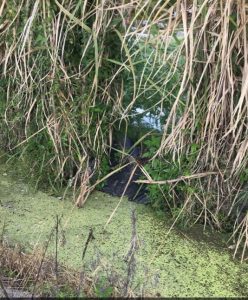(This blog post is first in a series recounting a summer internship opportunity for the author. Collaborating with Martin County 4-H Youth Development and Florida Sea Grant extension agents, this account provides a unique perspective on the career development of young adults into UF/IFAS Extension professionals.)
What Was Old is New Again
As a third-year student in the College of Agriculture and Life Sciences at the University of Florida, I never thought I would use my high school notes again. Advanced International Certificate of Education (AICE) Marine Sciences, a course concentrating on the scientific study of the sea and its ecosystems, was definitely not going to be saved for posterity. After all, I was going on to study Family, Youth and Community Sciences, a social science major. But in retrospect, I am very glad I did not put those notes in the recycle bin after all! As I prepare for the Junior Water Academy, an interactive water education program for 4-H youth, I’m reminded how human activities ultimately depend upon the natural resources, and particularly those related to water.
Looking back on my AICE class notes, I rediscovered the term eutrophication found in Chapter 3: “Energetics of Marine Ecosystems”. Here I wrote that eutrophication is algae bloom due to excessive nutrient runoff. It contributes to biomagnification (a term referring to how toxins move up the food chain). The fresh look at my past notes greatly aids my research. I am becoming more knowledgeable about the history of algal blooms and how they affect water and health impacts to Martin County communities. Here is a link to a Water Ambassador Program which focuses on the algal bloom issue!
A New Path Forward
Through my summer internship with UF/IFAS Extension, I will be able to develop a better understanding on how Extension outreach positively impact the lives of individuals, communities, and the counties as a whole. As a Palm Beach County native, I am excited to learn about the dynamics and attractions of Martin County, such as the Indian River Lagoon. 4-H Youth Development aligns perfectly with my major in Family, Youth, and Community Sciences. Helping to plan, organize, and execute the Junior Water Academy adheres to my interest in working with youth as well as my newfound interest for the environment. I am ready to dive deep into all things water: learning, teaching, and bringing valuable information and skills back to Gainesville to foster success in my community beyond the summer.
Before I began working on this 4-H/Sea Grant project, I did not truly understand the magnitude of the harmful algae blooms. In fact, my naivete was most evident as I came across a wetland last year.

While visiting a local farm, I decided to take a shortcut to a nearby strawberry field. I began walking through a grove of trees. But what at first looked to me like a grassy piece of land was actually algae on top of the water! Lesson learned: “Look before you leap”.
Taking on this new summer adventure, little did I realize how quickly I would be diving into my Extension internship to help bring the next generation of Floridians a little bit closer to tackling one of our state’s most pressing issues: water.
by Madison Borman; University of Florida CALS Intern
 0
0
